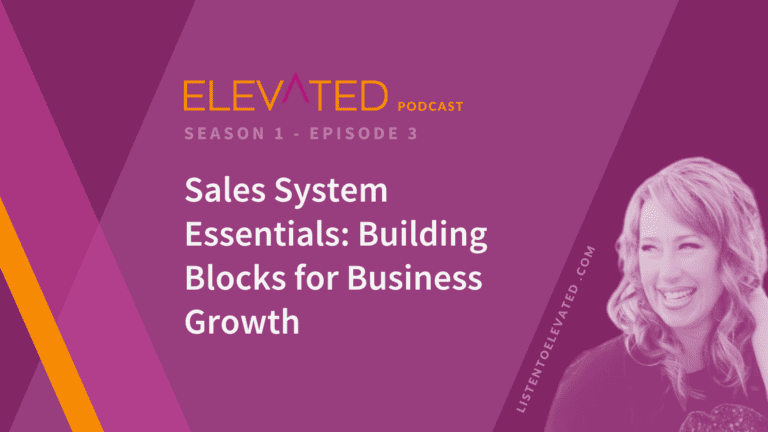Sales System Essentials: Building Blocks for Business Growth

No business owner I know started out as a professional sales person. I’m sure there are some, and good for them – because sales is absolutely critical to every business. For those of us that came from having expertise and then trying to sell it… sales can be terrifying.
But like every other aspect of business, be it finance, marketing or project management, there is a structure sales follows and it is a skill that can be learned.
In this episode, we are specifically approaching sales from the systems perspective, but to have a productive discussion about it, we need to be on the same page for the structure of the sales process. Having this shared definition and vocabulary makes it a lot clearer on how to track and evaluate success in the system, which we’ll be discussing in upcoming episodes.
Empowering Your Sales Process through Clarity and Terminology
When you have clarity on the specific steps that people take to become clients, not only can you begin to improve and predict the system, but it also skyrockets the confidence you have in that system being able to deliver the results you want.
Let’s get into the nitty gritty here on terminology and the definition of the sales process.
We’ll start with the terms used in the sales process. Likely none of this is completely new territory for you, but I want to make sure we have a shared understanding so that there’s no confusion later when we are wading into the systems.
Okay – let’s start with a prospect. A prospect is a person or company you’ve identified as a potential client for your service.
Establishing a Common Language: Sales Terminology Demystified
Next up – Lead: A lead is a person that has expressed interest in your service. Said another way, a lead is a potential client who has taken some action indicating an interest in what you have to offer. A prospect turns into a lead when they’ve responded to an email or phone call from you confirming their interest.
Now we are going to talk about two categories of leads, Marketing Qualified Lead (MQL) and Sales Qualified Leads (SQL). It is possible that this kind of lead categorization is new to you, or maybe you haven’t spent much time thinking about this because you are too busy working the leads you have.
Optimizing Sales Leads: Strategies for Effective Prioritization
Categorizing leads this way helps to make your sales process more effective because salespeople are able to prioritize leads that are hotter, that is they have more indications of wanting to buy now. Each business sets up their own criteria for when a lead gets moved into one of the categories, and these criteria can change over time.
A Marketing Qualified Lead (MQL) has typically shown interest and has interacted with your brand in ways that suggest potential for becoming a paying client, such as downloading content, booking a consult, or attending a webinar. If someone signs up for the newsletter, they are a lead. If they then download the budget calculator mentioned in a welcome email, they would then become a Marketing Qualified Lead.
From Prospect to Sale: Navigating the Sales Journey with Confidence
A Sales Qualified Lead (SQL) is a prospective client that has been vetted and is deemed ready for the next stage in the sales process. Essentially, an SQL has the means and the authority to make a purchase decision. For Kitchen & Bath Design businesses, the most likely criteria for becoming a SQL is having the right budget and being ready to make a purchase decision in the next 30 days.
Now that we’ve got the terminology handled, we can walk through the sales process. The sales process is moving someone from prospect or a lead, through qualification, into the design consultation (in sales terms, this is a needs analysis). From there, a proposal is presented in the form of a design and quote and then the sale is closed when the client signs the agreement and pays the deposit.
Sure, it all sounds so simple like that, but we both know that in reality it can be more complex when hiccups happen between stages or there is uncertainty on any of the qualification criteria.
However, the complexities are much easier to see and deal with when the process is outlined, qualification criteria are clear and the information is in a trackable system.
In the next episode we’ll be on the sunny side, talking about what makes a good sales system. Don’t worry, you can keep it simple and still have a good sales system. What makes it good is the results it gives you, not how complicated the technology is.
Heads up – High-er Help, my book on how to use experts to shortcut improvement, growth & capacity is launching October 23! Be the first to get the details on High-er Help and pre-order by going to higherhelpbook.com.
Was this episode helpful? Take a moment to rate & review this podcast. Rating us helps other Kitchen & Bath design business owners discover our episodes.

